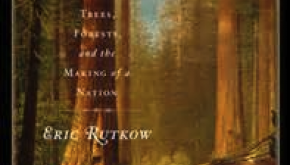
American Canopy: Trees, Forests, and the Making of a Nation by Eric Rutkow (Scribner, 2012)
In the seminal text Wilderness and the American Mind (Yale University Press, 1967), Roderick Nash focuses on a historical interpretation of wilderness. Now we have an extension of such an approach with Eric Rutkow’s American Canopy: Trees, Forests, and the Making of a Nation. Here Rutkow focuses on trees, weaving a fascinating history of our nation through the foundation of our American relationship to trees. By seeing the historical lens of American formation through trees, Rutkow’s breadth includes a conservation, historical, and philosophical focus on trees as the foundation of our communities, laws, and civic virtues and vices. Rutkow writes, “How easy it is to forget that much of American history has been defined by trees.”
There is fascinating background about how New England furnished masts for the (British) Royal Navy, about the proliferation and meaning of Liberty Trees, and about cherry trees (the sakura) planted in Washington D.C. that were gifts from Japan. Deeply embedded in the gift of cherry trees was the parallel formation of the USDA’s “broad powers to inspect plant importations, target suspected threats, and issue quarantines as needed.”
Our relationship to trees reveals, perhaps, an American consciousness about our land and use of it. In this eminently readable book, which is a page-turner, we learn the long history of that tree consciousness. It’s a historical boom and bust relationship that turns in the contemporary era, in Rutkow’s view, to a question of environmental ethics. In the penultimate unit “Postwar Prosperity,” Rutkow writes:
The postwar years had produced fundamental shifts in the American landscape. Farms and fields yielded to suburbs; private forest began to function as tree plantations; public forests became sites of leisure; and great swaths of land were transformed into official wilderness….
This period had also seen a remarkable change in the way that people thought about trees. On the one hand, wood had become much less conspicuous in daily life…. On the other hand, the nation’s forests had grown much more accessible.
While the historical sections, beginning with pilgrims, are fascinating, Rutkow makes no mention of Native Americans and their use of trees, and land-use practices, before the arrival of colonial powers. We have the masts for the Royal Navy, but where are the canoes made from single tree trunks? This seems a glaring oversight in such a wide-ranging and compelling book. The final unit lacks cohesion because, to this reader at least, much of Rutkow’s contemporary information on forestry reads as out-of-date. Why not focus on the non-industrialized timber owner efforts, such as the ones of IFOA members, for example? Some hands-on descriptions would bring the latter chapters to life in the way that the author Jack Nisbet has so viscerally brought David Douglas to life. (Surprisingly, David Douglas is not mentioned in American Canopy.) Nevertheless, American Canopy is a very good book, and wonderfully readable, and I highly recommend it.
[This book review previously appeared in the Idaho Forest Owners Association Newsletter.]

